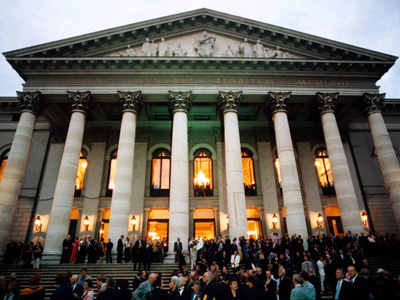by Albert Innaurato
I went to Bellini’s Norma at the Met on Friday. I was late to the party, Sondra Radvanovsky’s Norma has been praised as a throwback to greatness by many of the easily enraged hard core — and some of these people have been seeing international performers of this huge role for 60 and more years! But just that morning, there had been the dress rehearsal for Nico Muhly’s new opera, Two Boys. For a moment it had looked as though I might go to this but I’ll have to wait and see how Muhly’s opera is received, and most importantly, whether it can be one of the baby steps crucial to whether opera can walk again.
The arts we inherited from the 19th century are dying in America. A large group of successful new works would be one prong of a survival strategy, saving opera, for example, from seeming merely bizarre. Funding is another prong. Arts are subsidized in Europe and don’t appear to be in such trouble, but the Not for Profit system in America has failed badly. All the arts are charities, all artists, beggars, and as our society gets poorer, losing its middle class, the demands on that 1 or 2 % with money to spare are enormous. Does one give to cancer research or the Metropolitan Opera, to feeding Americans or to the ballet, to desperately backward schools or the symphony? And how does anyone persuade those two or three multinational, profit besotted hydras determined to control what everyone thinks and knows to add any of the arts to multi-channel cable systems on a regular, easily accessible basis, knowing that at first, few people will watch?
But it’s easier to focus on this instant, knowing as one who is terminally ill knows, that things end, that America is a nation jammed with the uncaring, the indifferent and the stupid (sorry, I mean those with “low information”). We old timers cry: “let us sit in a circle and download the old days and if that fails, let’s hold hands and remember!”
Miss Radvanovsky is that currently rare thing, a professional singer of the highest standard for whom no excuses need be made. She has a strong technique, excellent coloratura, a very wide range with rafter shaking high notes when she wills, a glistening, easily controlled pianissimo — a very soft tone that still fills the huge opera house. She is a musician, she is tasteful. She was boring.
But can Norma, a great opera, no doubt, a high water mark of early romanticism, adored by nearly every important musician of the time, an influence on Richard Wagner (“without Bellini there would be no Wagner” he said) as well as Verdi, and Chopin and Mendelssohn and Schumann and on and on, rip our hearts out today as Bellini intended? Well, not in the sort of performance the Met gave, proficiently but unimaginatively conducted by Riccardo Frizza who evidently didn’t coach the singers in the style, or as the only native speaker in the production, get them to pay attention to their words (Bellini certainly did). Not with an Adalgisa who forced a small voice and lacked command in her difficult moments, and not with a clueless, bullish Pollione, and not with an ancient Oroveso who just stood around while his world fell apart, as indeed it does in the last scene.
Years ago (and yes, I was there years ago), Norma would have known that in the crucial moment where she decides not to sacrifice her innocent rival, Adalgisa, but to reveal herself as the villain in the eyes of her people and says simply, “son io” (“it is I” — who have betrayed you), that this was a moment to be seized for us to see the agony in this heroic woman as she fights within herself; and painfully, slowly, with profound sorrow and even fear condemns herself to death. The pain, self revelation, shame and grandeur should stop one’s heart. But Radvanovsky didn’t know how to do that, and in the whole great opera house, there was no one to tell her.
She is too accomplished and intelligent a singer to be damned with faint praise; the last twenty minutes, a massive challenge, were sung with remarkable command. But where does the instinct to perform these roles with the essential emotional commitment come from? Is a technically expert but generalized performance another symptom of how opera is dying?
Let’s hope the gifted Muhly, writing about how we live now, with singers who understand their characters implicitly, has managed a work and gets a performance that shocks and thrills and moves real people through music. And let’s hope that the remarkable Radvanovsky finds someone to stimulate her into the intense personal connection to those grand old roles that she did not have.
Alberto rages rather than babbles at http://mrsjohnclaggartssadlife.blogspot.com/



In Your Face, Astrid
October 17th, 2013By ANDREW POWELL
Published: October 17, 2013
MUNICH — Spirograph needlemaniac defaces legendary (and conveniently deceased) Brünnhilde. And so on.
Bavarian State Opera’s anticipated additions to its portrait gallery went public yesterday, their twenty-one victims — er, honored subjects — being depicted in various media by twenty-one visual artists. Scattered docent notes:
• Anja Harteros – toner light
• Astrid Varnay – best in person
• Brigitte Fassbaender – high treason
• Christian Gerhaher – sun shines out of his … mouth
• Diana Damrau – per pietà
• Dietrich Fischer-Dieskau – cluster analysis
• Edita Gruberová – background material
• Fritz Wunderlich – for Hasselblad
• Hermann Prey – about to …
• Hildegard Behrens – Dietrich? Garbo? both?
• Jonas Kaufmann – David? Cellini? finished?
• Júlia Várady – ready for her close-up
• Klaus Florian Vogt – Brabant H.S.
• Kurt Moll – a wash
• Lucia Popp – monochrome Sophie
• Margaret Price – unmasked!
• Peter Seiffert – got THaT rigHt!
• René Kollo – eye, nose, mouth, eye
• Waltraud Meier – Broadway-bound
• Wolfgang Brendel – every inch the Bavarian
• Wolfgang Koch – unhappy camper
The needleman in question is Maurizio Anzeri, a London-based Italian whose stock-in-trade is embroidered photography, much of it stunning though not usually intended to depict a specific person.
Anzeri likes to cover a face, spurred on perhaps by its energy. It is unclear why, but the Freunde des Nationaltheaters München e.V. chose him to portray soprano Astrid Varnay, and he has overcome the obvious hurdle by recourse to a diptych (shown). Whether he listened to her work for inspiration or direction, or has sensed what she achieved, is anyone’s guess.
Raised in New Jersey, Varnay debuted at the Metropolitan Opera at the age of 23 singing Wagner’s Sieglinde and, days later, Brünnhilde. After successes in the 1950s at Bavaria’s Bayreuth Festival as well as at Bavarian State Opera, she settled in Munich and is buried here.
Photo © Bayerische Staatsoper
Related posts:
Portraits For a Theater
Petrenko Preps Strauss Epic
A Complete Frau, at Last
Petrenko Hosts Petrenko
Poulenc Heirs v. Staatsoper
Tags: Anja Harteros, Astrid Varnay, Bavarian State Opera, Bayerische Staatsoper, Brigitte Fassbaender, Christian Gerhaher, Commentary, Diana Damrau, Dietrich Fischer-Dieskau, Edita Gruberová, Fritz Wunderlich, Hermann Prey, Hildegard Behrens, Júlia Várady, Klaus Florian Vogt, Kurt Moll, Lucia Popp, Margaret Price, Maurizio Anzeri, München, Munich, National Theater, Nationaltheater, News, Peter Seiffert, René Kollo, Waltraud Meier, Wolfgang Brendel, Wolfgang Koch
Posted in Munich Times | Comments Closed